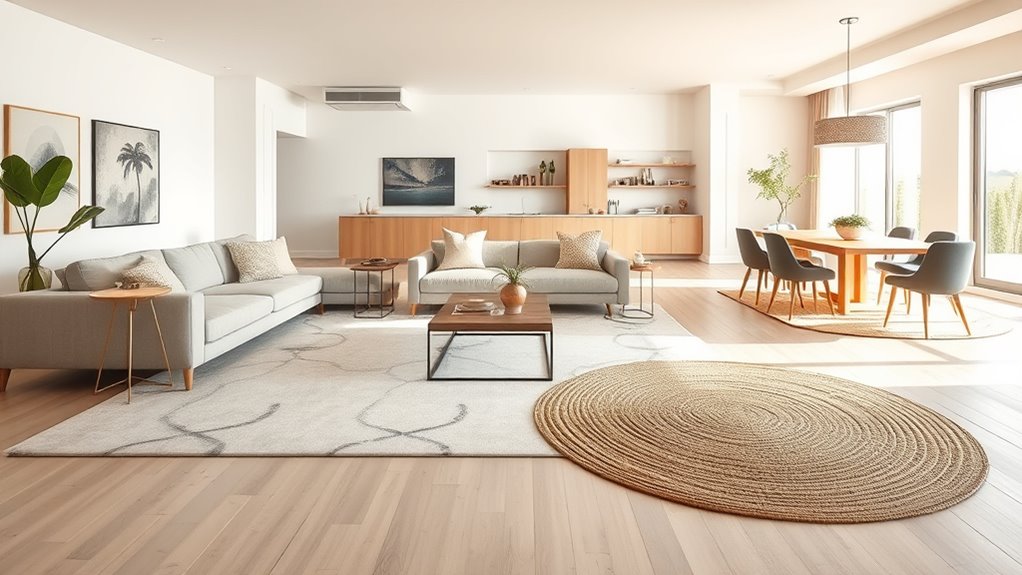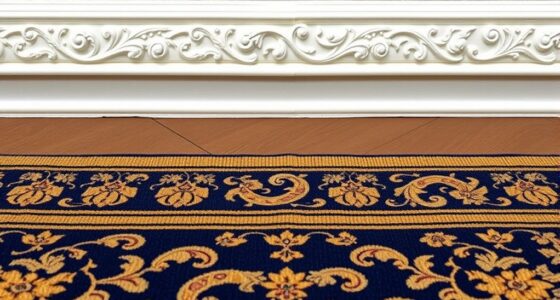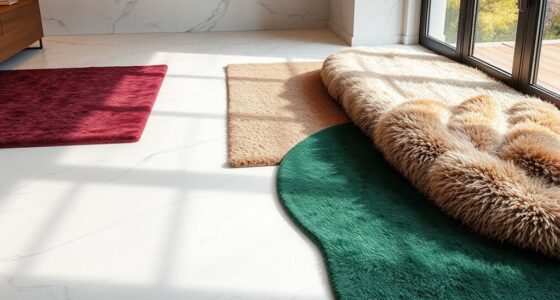For open-plan living rooms, choosing rug shapes like rectangular, round, or square helps define zones and improve flow. Rectangular rugs are versatile and classic, great for anchoring furniture, while round rugs add softness and coziness to seating areas. Square rugs promote symmetry, and irregular or abstract shapes introduce visual interest. Runners can create pathways, and layering different shapes adds depth. If you keep exploring, you’ll discover how to select the perfect rug shapes for your space.
Key Takeaways
- Rectangular rugs define zones and complement open layouts with classic, versatile shapes.
- Round rugs add softness and coziness, ideal for seating areas and creating relaxed atmospheres.
- Square rugs promote symmetry and help organize open spaces with balanced visual weight.
- Irregular or abstract rugs serve as bold focal points, adding artistic interest and unique character.
- Runner rugs effectively mark pathways and delineate boundaries within open-plan living areas.
Rectangular Rugs: Classic and Versatile
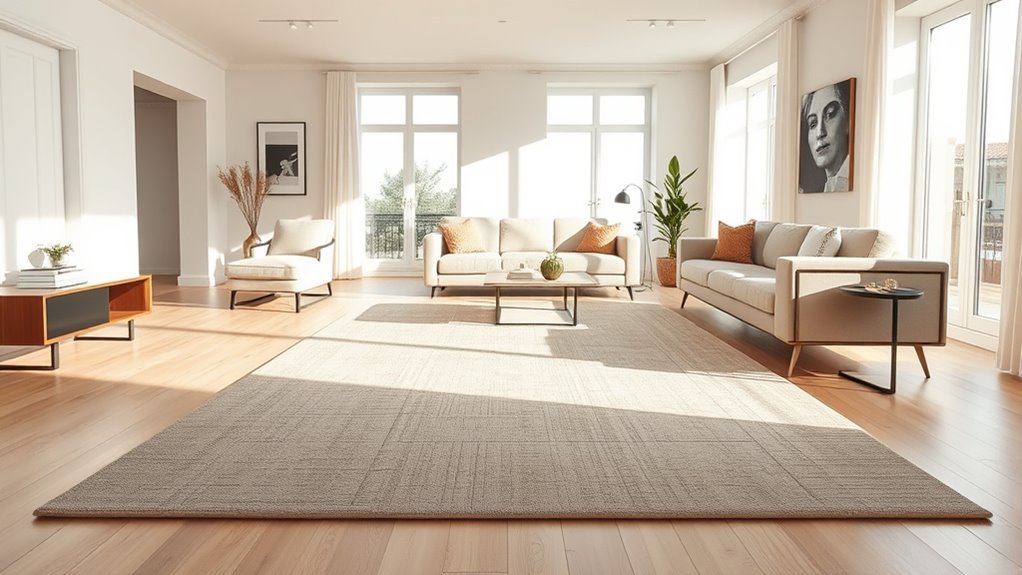
Rectangular rugs are a timeless choice that easily complements the layout of open-plan living rooms. Their shape helps define separate zones, making your space feel more organized. When selecting a rug, consider rug materials like wool, synthetic fibers, or natural fibers, which impact durability and ease of rug cleaning. Wool rugs are plush and naturally stain-resistant, perfect for high-traffic areas. Synthetic rugs are budget-friendly and easy to maintain. Natural fiber rugs, such as jute or sisal, add texture and eco-friendliness but may require more careful rug cleaning. The rectangular shape provides flexibility in placement, whether under your seating area or along a hallway. Choosing the right materials guarantees your rug stays beautiful and functional, enhancing your open-plan living space. Additionally, understanding color accuracy and contrast ratios can help you select rugs that complement your overall interior design and lighting conditions. Incorporating resilient materials can further ensure your rug remains attractive over time, especially in dynamic living environments.
Round Rugs: Soft Curves for a Cozy Feel
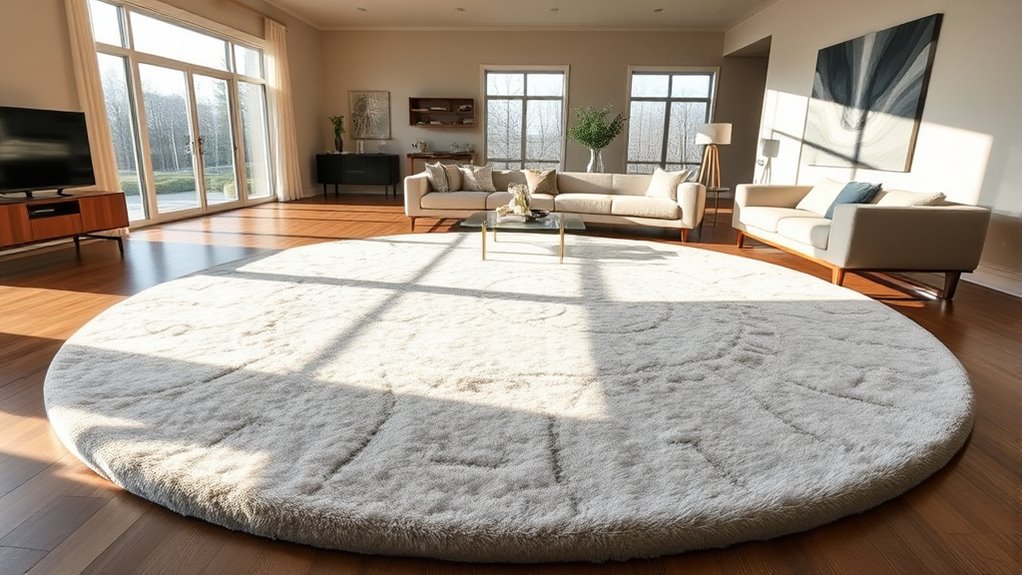
Round rugs introduce gentle curves that soften the overall look of your open-plan living space, creating a warm and inviting atmosphere. Their shape naturally encourages a relaxed, cozy vibe, making them perfect for defining seating areas. You can choose rugs with floral patterns to add a touch of elegance and charm, or opt for plush textures that invite you to sink in and relax. The softness of plush fibers enhances comfort and makes your space feel more intimate. Round rugs work well under coffee tables or around sofas, helping to balance the room’s layout without creating harsh lines. Their curves contrast beautifully with straight edges, adding visual interest while maintaining a welcoming, cozy feel throughout your open-plan living room. Incorporating elements like farmhouse furniture can further enhance the warm, rustic charm of your space. Additionally, choosing a rug with diverse designs can elevate your decor by adding personality and style. Including size considerations ensures the rug fits seamlessly within your room’s layout, enhancing both functionality and aesthetics.
Square Rugs: Structured and Symmetrical

Square rugs bring a sense of order and balance to your open-plan living room. They enhance the room’s symmetry and create clear zones within the space. If you want a clean, structured look, these rugs are an excellent choice. Additionally, choosing a square rug can help define the emotional boundaries of different areas, which is especially useful when managing complex relationships or personal space. Incorporating self watering plant pots can further enhance the farmhouse charm and provide a cozy atmosphere. Understanding production quantity variance can also be useful when planning your space, as it helps in managing resources efficiently and ensuring your decor choices stay within budget.
Enhances Room Symmetry
Because they have clean lines and balanced proportions, square rugs naturally create a sense of order and harmony in open-plan living rooms. Their symmetry draws attention to focal points, grounding the space and making areas feel cohesive. By aligning furniture and decor with the rug’s shape, you enhance overall room symmetry, making the layout feel more intentional. Square rugs also support effective color coordination, allowing you to match or contrast hues seamlessly across the room. This consistency reinforces visual balance, ensuring no area feels disconnected or off-balance. When you choose a square rug, you reinforce the room’s symmetry, making the space feel more organized and inviting. It’s an easy way to achieve a polished look while emphasizing the room’s natural flow. Additionally, understanding the importance of attention in creative practice can help you carefully select design elements that draw focus and enhance the aesthetic balance.
Defines Open Space
Structured and symmetrical, square rugs help define open spaces by creating clear boundaries within a room. In interior design, they establish a visual anchor that separates different zones, even in an open-plan layout. When you choose a square rug, it guides your furniture placement, making it easier to arrange seating and tables harmoniously. The balanced shape emphasizes order and structure, helping your space feel organized rather than chaotic. Using a square rug signals a specific area within the larger room, which is especially useful when multiple functions coexist, like lounging and dining. This shape also enhances symmetry, contributing to a cohesive look. Additionally, the geometric form of square rugs can complement other design elements that emphasize visual balance and harmony. Incorporating a square rug can also assist in space planning by providing a clear framework for furniture arrangement. Choosing the right size and texture of a square rug further enhances the design flow of your open-plan living area. Overall, a square rug offers a practical way to delineate and visually organize your open living space. Facilitate collaboration among diverse design elements to create a harmonious environment.
Irregular or Abstract Rugs: Artistic and Unique
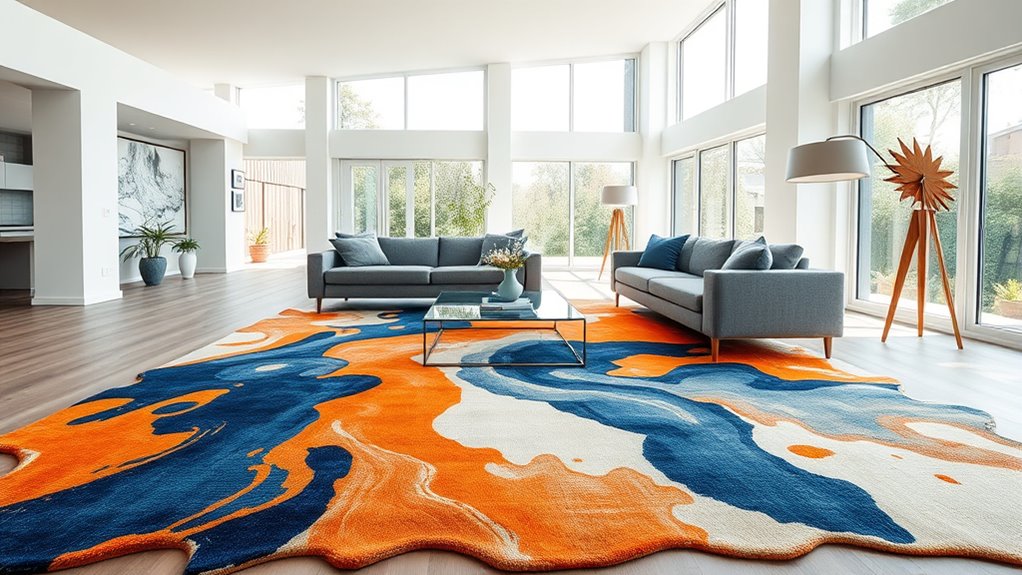
Irregular or abstract rugs bring a bold, artistic touch to open-plan living rooms, turning the space into a canvas of creativity. Their unique shapes and lively designs add visual interest and express your personal style. With a wide pattern variety, you can find rugs that range from swirling colors to geometric chaos, making your space truly one-of-a-kind. Material options are just as diverse, including plush wool, sleek silk, or durable synthetic fibers, allowing you to choose based on comfort and maintenance needs. To maximize impact, consider these tips:
- Select a rug with a striking abstract pattern to serve as a focal point.
- Mix materials for texture and visual depth.
- Use irregular shapes to define zones or seating areas creatively.
Additionally, understanding geometric chaos can help you select patterns that complement your overall decor style. Exploring creative rug layouts can also inspire more innovative design ideas for your living area. Incorporating personal style into your rug choices ensures the space reflects your unique taste and personality.
Runner Rugs: Defining Pathways and Zones

Runner rugs are perfect for signaling pathways and creating distinct zones in your open-plan space. They help clarify boundaries, making navigation easier and more intuitive. Plus, they add a visual flow that ties different areas together seamlessly. Incorporating layer concepts into your design can enhance organization and overall harmony within the space. Additionally, choosing the right rug shapes can complement your layout and improve the functionality of each zone. Embracing space optimization strategies can also make your open-plan living room feel more cohesive and well-structured, especially when considering the diversification of assets for a balanced and versatile interior design.
Clarifying Pathway Boundaries
To effectively define pathways and zones in an open-plan living room, runner rugs serve as practical visual guides. They help you clarify traffic flow and separate different areas seamlessly. When choosing a runner, consider these tips:
- Opt for color coordination that complements your overall decor, making transitions smooth and cohesive.
- Select material durability to withstand foot traffic, especially in high-use pathways.
- Guarantee the size and placement clearly mark the pathway without encroaching on other zones.
- Choosing a runner with appropriate material durability helps maintain its appearance and function over time, especially in high-traffic areas.
A well-chosen runner keeps your space organized and inviting, guiding movement while enhancing style. It’s a simple way to create distinct pathways without losing the open feel. Properly defined borders improve functionality and aesthetic balance effortlessly.
Establishing Visual Zones
Establishing visual zones in an open-plan living room helps create a sense of order and intimacy within a spacious area. One effective way is through strategic color coordination; choosing rugs that complement or contrast with nearby furniture helps define different zones clearly. Runner rugs are perfect for marking pathways, guiding movement, and separating seating areas from dining or workspaces. Material selection also plays a key role: plush fibers invite relaxation in lounging zones, while low-pile options suit high-traffic pathways. By carefully selecting rug shapes and sizes, you can visually distinguish each zone without cluttering the space. This approach not only enhances functionality but also adds aesthetic cohesion, making your open-plan living room feel more inviting and organized.
Large Area Rugs: Creating a Unified Space
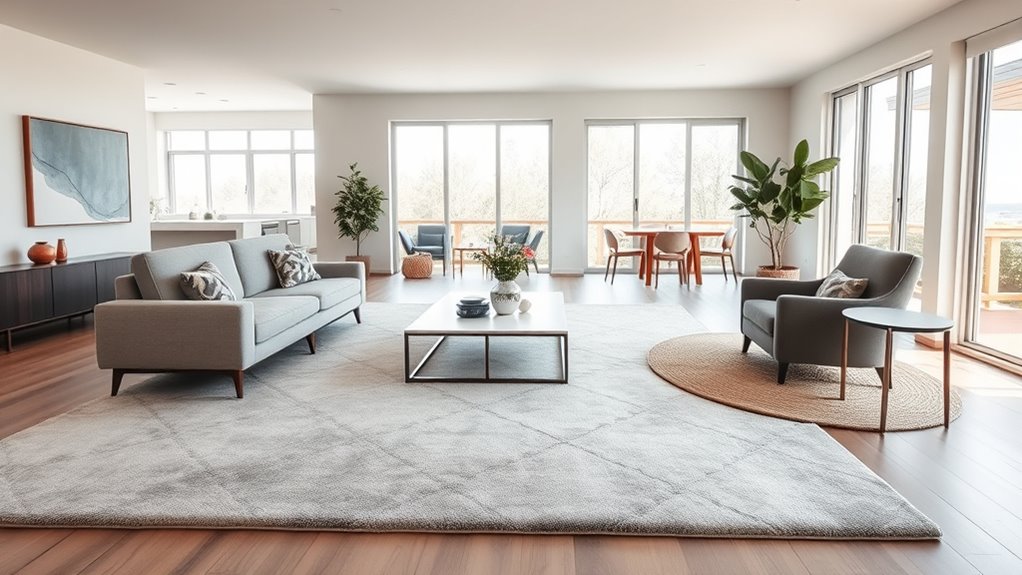
Large area rugs are essential for creating a cohesive look in open-plan living rooms. They unify different zones and define the overall space. To maximize their impact, consider these tips:
- Choose rugs with complementary colors to ensure smooth color coordination across furniture and walls.
- Opt for durable materials that are easy to maintain, making rug upkeep manageable over time.
- Select a size that covers enough floor area to anchor your furniture, creating a seamless, unified appearance.
A well-chosen large rug not only enhances style but also simplifies rug maintenance by reducing dirt and wear in high-traffic areas. When carefully selected, it ties your space together beautifully and practically.
Small Accent Rugs: Adding Detail and Depth

Small accent rugs can instantly add detail and depth to your open-plan living room, creating visual interest without overwhelming the space. They offer a variety of texture options, such as plush, woven, or shaggy styles, which can introduce tactile variety and warmth. When choosing a small rug, focus on color coordination to complement your existing décor; a rug in a contrasting hue can highlight a specific area, while a tone-on-tone option maintains subtlety. These rugs are perfect for defining zones like a reading nook or accenting a piece of furniture. By carefully selecting textures and colors, you enhance your space’s layered look, adding personality and depth without cluttering the overall layout. Small accent rugs are a versatile tool to refine your open-plan living room’s aesthetic.
Layering Rugs: Combining Shapes for Visual Interest
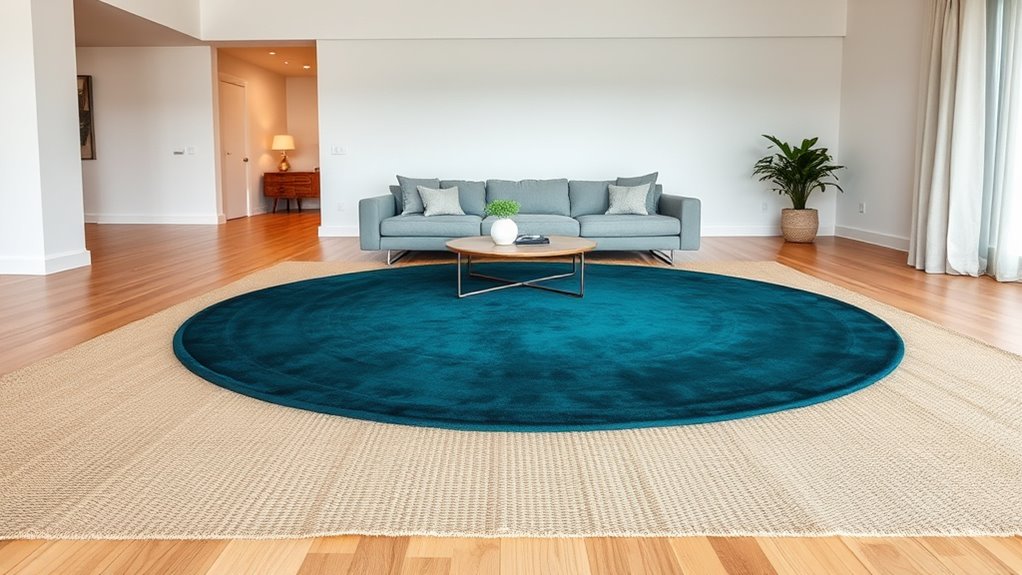
Layering rugs by combining different shapes can instantly elevate the visual interest of your open-plan living room. To create a cohesive look, focus on color coordination—use rugs with complementary or contrasting hues to add depth. Mix shapes like rectangles with rounds or squares to break the monotony and highlight different zones. When layering, consider these tips:
Layer rugs with varied shapes and colors for a vibrant, cohesive open-plan living space.
- Balance sizes and shapes to avoid clutter and ensure easy rug maintenance.
- Stick to a consistent color palette to unify the layered look.
- Use smaller accent rugs to add texture and visual interest without overwhelming the space.
Custom-Shaped Rugs: Tailoring to Your Layout

While mixing shapes adds visual interest, customizing rugs to fit your unique space can create a seamless and cohesive look. Tailoring a rug’s shape to your layout guarantees it complements your furniture and room flow. Consider color coordination to unify the space—matching or contrasting rug hues with your furniture and walls enhances harmony. Material texture also plays a key role; a plush, textured rug can add warmth and comfort, while sleek materials create a modern feel. Custom-shaped rugs, like semi-circular or irregular designs, can fit awkward corners or open areas perfectly, making your living room feel intentional and well-designed. By selecting the right shape, color, and texture, you craft a space that’s both functional and visually appealing.
Frequently Asked Questions
How Do Rug Shapes Influence the Overall Room Perception?
Rug shapes markedly influence your room’s perception by guiding the visual flow and defining space. A rectangular rug emphasizes length and creates a sense of order, while a round rug softens the room’s edges, making it feel more inviting. Using different shapes helps with spatial division, highlighting separate zones without walls. You can play with these options to enhance openness, balance, and functionality in your open-plan living room.
What Are the Best Rug Shapes for High-Traffic Open-Plan Areas?
In high-traffic open-plan areas, you want area rug styles that withstand wear and tear, like low-pile or flat-weave rugs. Rug material choices such as wool or synthetic fibers are durable and easy to clean. Rectangular or runner shapes work well because they define zones without overwhelming the space. These shapes and materials help you create a functional, stylish environment that stays looking fresh despite constant use.
Can Multiple Rug Shapes Work Together Harmoniously?
Yes, multiple rug shapes can work together harmoniously if you focus on pattern coordination. You can mix rectangles, rounds, and runners to define different zones, creating visual interest and flow. To make it seamless, choose area rugs with complementary colors or subtle patterns that tie the shapes together. This approach adds personality to your open-plan living room while maintaining a cohesive look.
How Do Rug Shapes Affect Furniture Arrangement in Open Spaces?
Rug shapes considerably influence your furniture arrangement by creating distinct zones and enhancing aesthetic balance. For example, rectangular rugs define seating areas, while round rugs soften corners and encourage flow. You can use different shapes to delineate spaces or unify the room’s look. By choosing the right shapes, you make your open-plan living room more functional and visually appealing, guiding movement and highlighting key furniture pieces effortlessly.
What Considerations Are There for Choosing Rug Shapes in Varied Ceiling Heights?
Choosing rug shapes with varied ceiling heights is like balancing a sculpture—you want harmony. If your ceiling is tall, go for larger, elongated rugs to fill the space and emphasize proportions. For lower ceilings, smaller or more compact shapes prevent the room from feeling cramped. Consider rug proportions carefully to make certain the shape complements the ceiling height, creating a cohesive and inviting atmosphere.
Conclusion
Choosing the right rug shape transforms your open-plan living room from simple to stunning. While a large, unified area rug creates cohesion, a small accent rug adds intricate detail. The interplay of structured rectangles against freeform abstract designs balances order with creativity. Ultimately, your choice reflects your style—whether it’s the classic elegance of a rectangular rug or the artistic flair of an irregular shape—turning your space into a harmonious yet dynamic haven.
